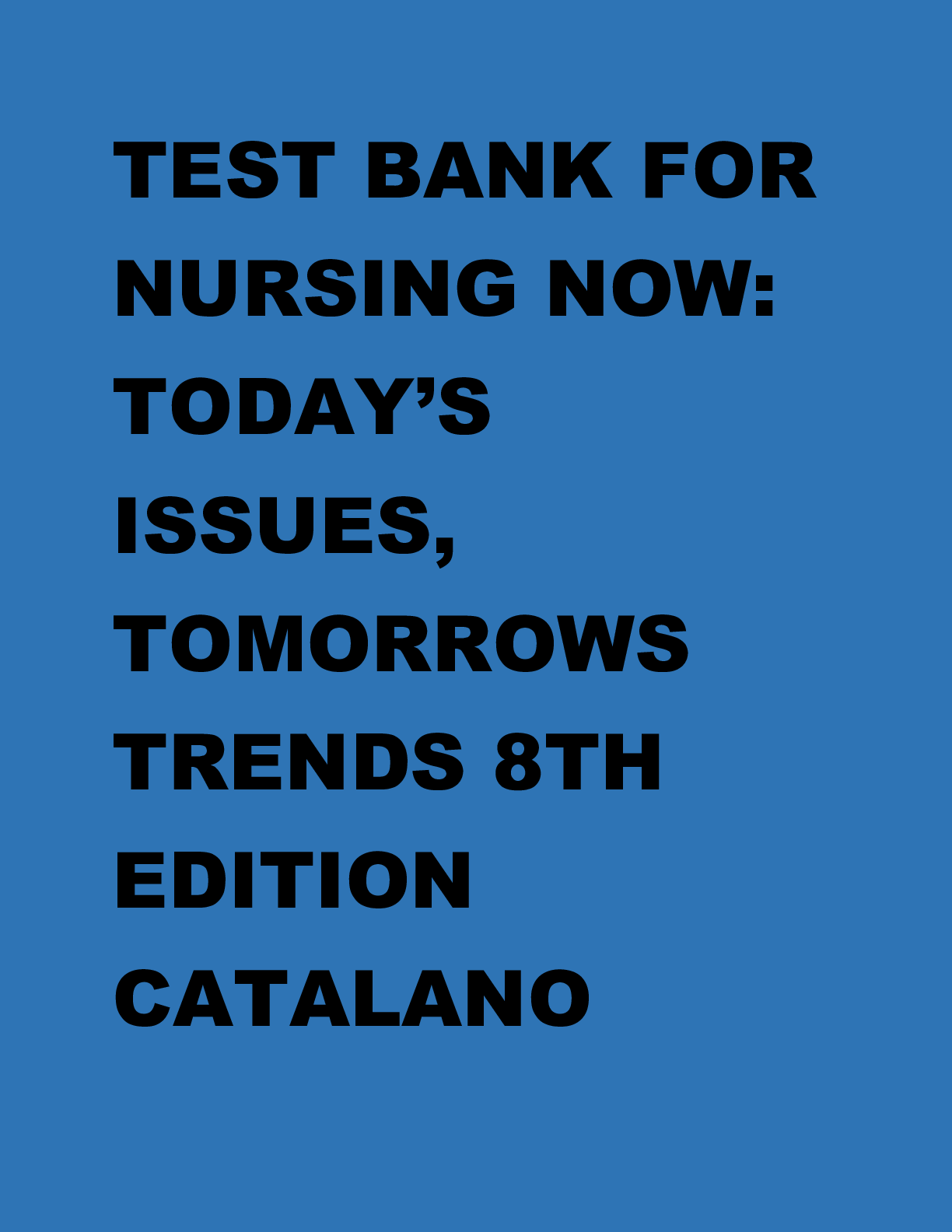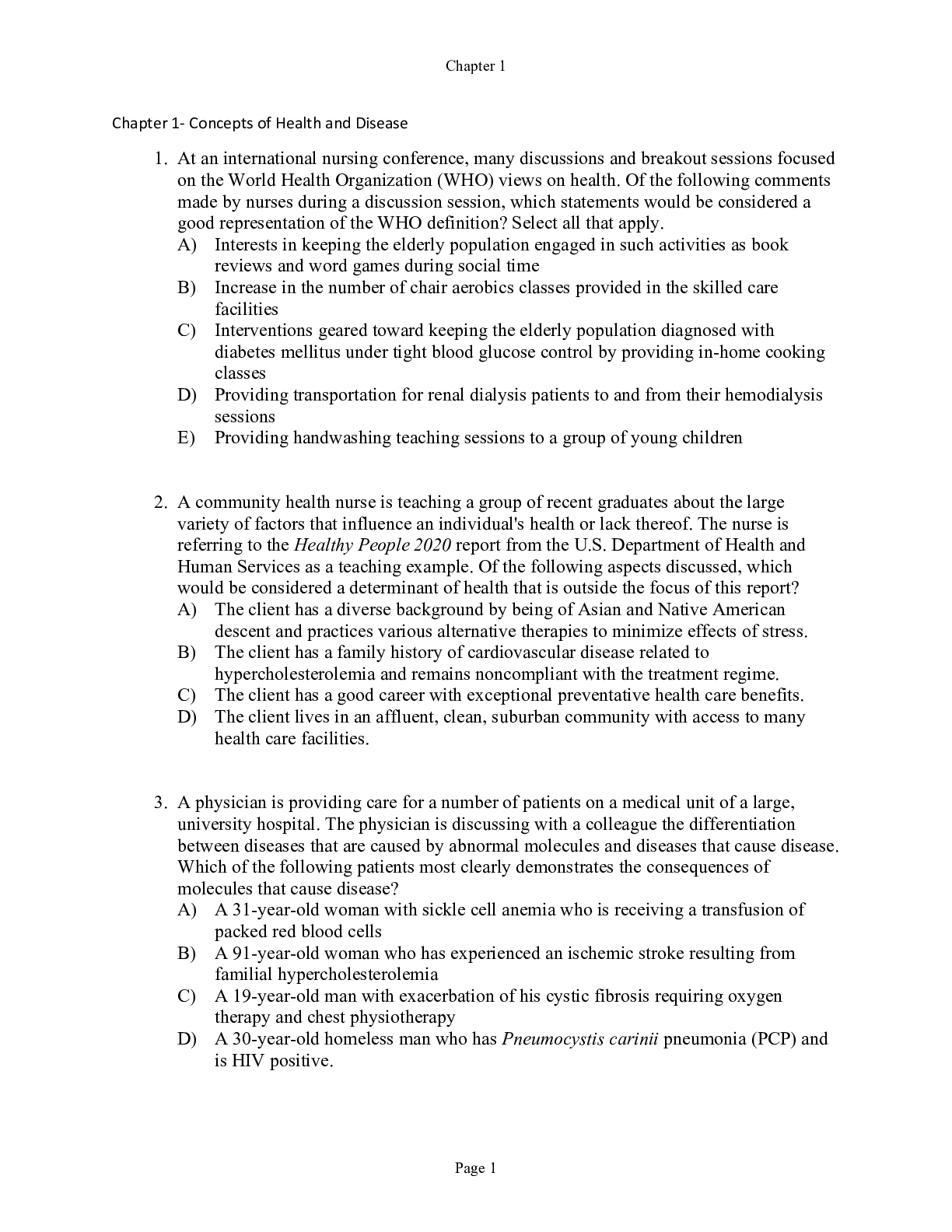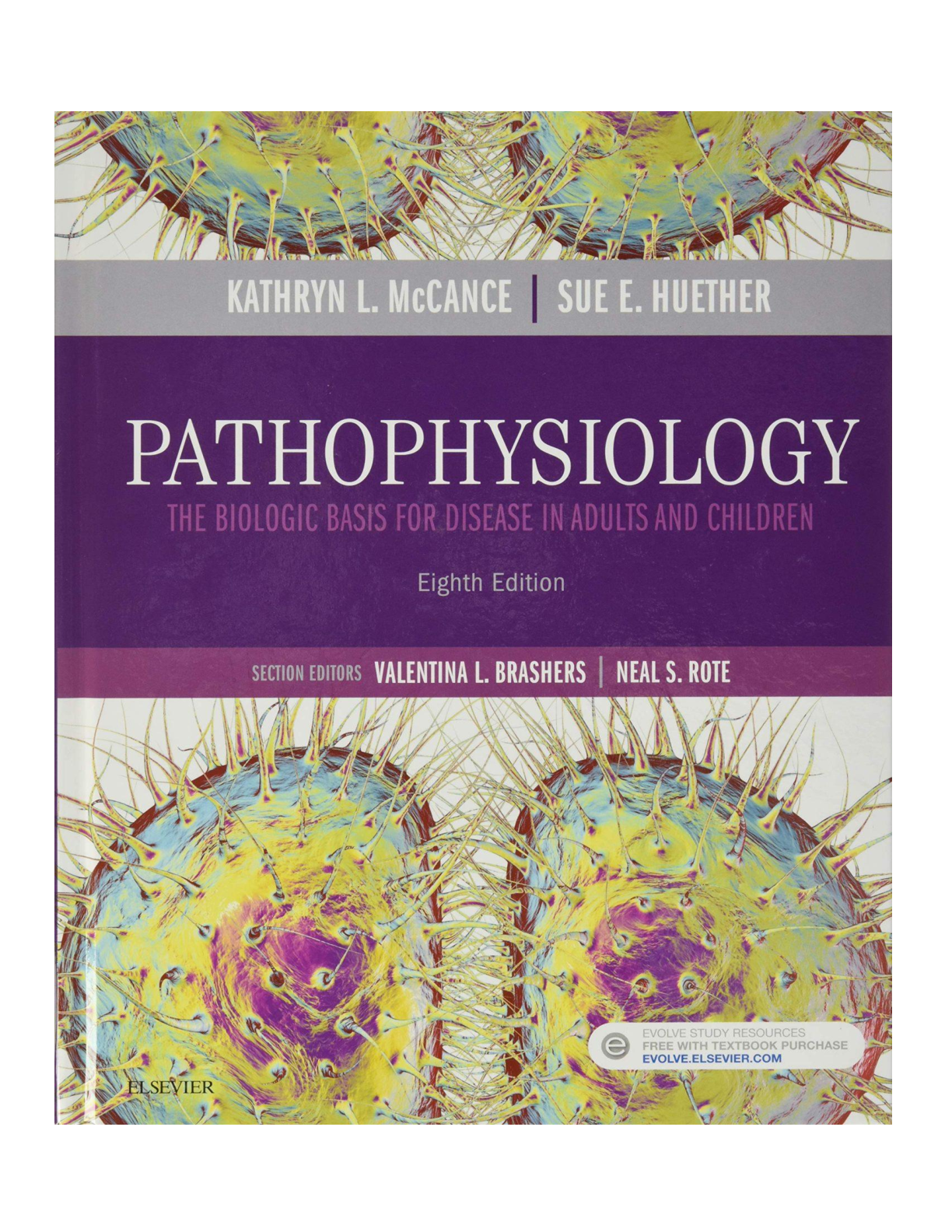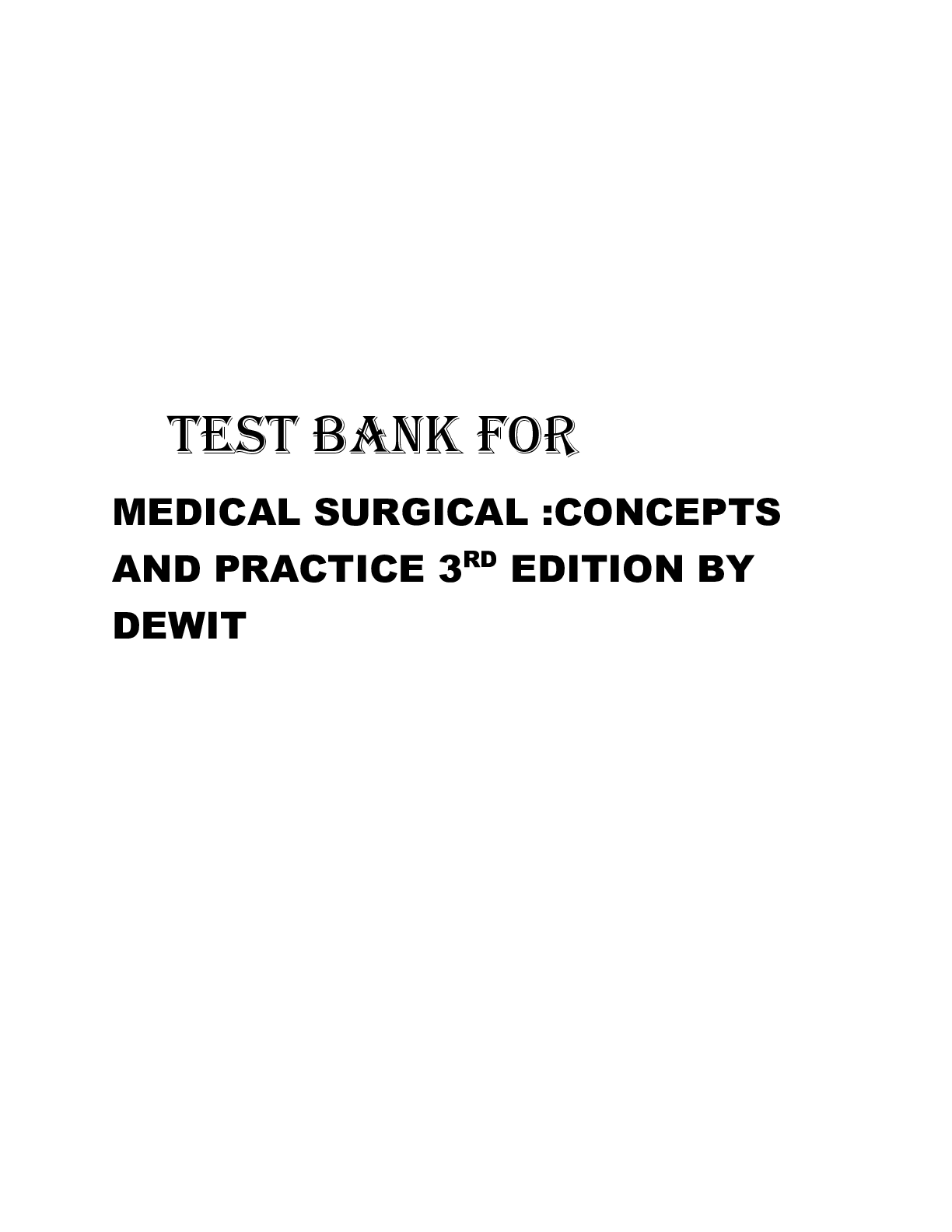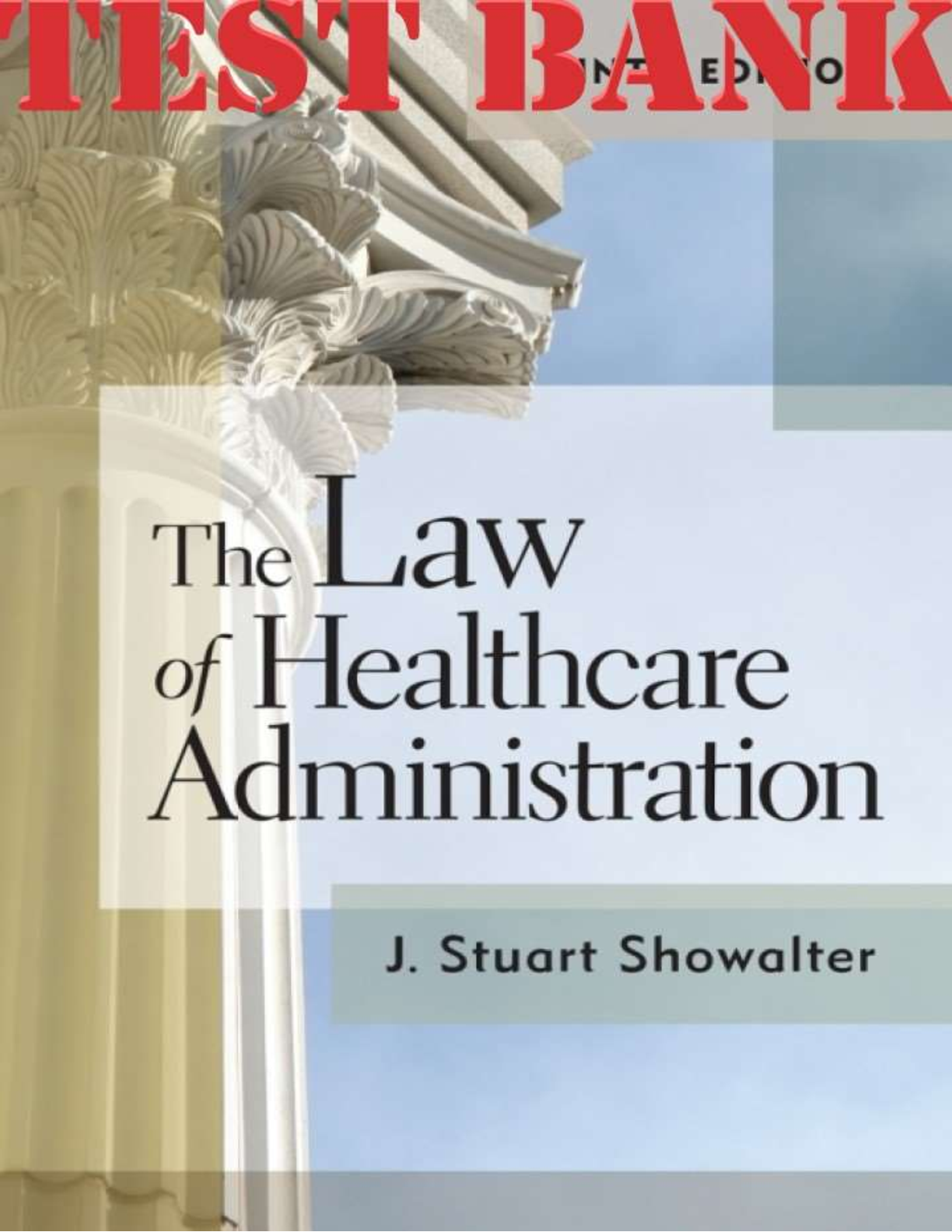*NURSING > TEST BANK > TEST BANK FOR NESTER’S MICROBIOLOGY A HUMAN PERSPECTIVE 9TH EDITION BY ANDERSON (All)
TEST BANK FOR NESTER’S MICROBIOLOGY A HUMAN PERSPECTIVE 9TH EDITION BY ANDERSON
Document Content and Description Below
Nester’s Microbiology, 9e (Anderson) Chapter 1 Humans and the Microbial World 1) The scientist usually considered the first to see microorganisms, which he called "animalcules," was ________. A)... Redi B) van Leeuwenhoek C) Pasteur D) Tyndall Answer: B Section: 01.01 Topic: History of Microbiology Bloom's: 1. Remember Learning Outcome: 01.01 Describe the key experiments of scientists who disproved spontaneous generation. ASM Objective: 02.01 The structure and function of microorganisms have been revealed by the use of microscopy (including bright field, phase contrast, fluorescent, and electron). 2) The word "animalcule" was first used by ________. A) Pasteur B) Redi C) van Leeuwenhoek D) Tyndall E) Hooke Answer: C Section: 01.01 Topic: History of Microbiology Bloom's: 1. Remember Learning Outcome: 01.01 Describe the key experiments of scientists who disproved spontaneous generation. ASM Objective: 02.01 The structure and function of microorganisms have been revealed by the use of microscopy (including bright field, phase contrast, fluorescent, and electron). 3) The idea of spontaneous generation postulated that A) organisms could evolve into the next generation of organisms. B) organisms could spontaneously turn into other types of organisms. C) living organisms could spontaneously arise from non-living material. D) living organisms could spontaneously arise from other living organisms. E) living organisms must contain at least ten cells. Answer: C Section: 01.01 Topic: History of Microbiology Bloom's: 2. Understand Learning Outcome: 01.01 Describe the key experiments of scientists who disproved spontaneous generation. ASM Objective: 02.01 The structure and function of microorganisms have been revealed by the use of microscopy (including bright field, phase contrast, fluorescent, and electron). 4) Which of these scientists were involved in investigating the idea of spontaneous generation? A) Redi and van Leeuwenhoek B) Redi and Pasteur C) van Leeuwenhoek and Pasteur D) Pasteur and Escherich E) Escherich and Redi Answer: B Section: 01.01 Topic: History of Microbiology Bloom's: 2. Understand Learning Outcome: 01.01 Describe the key experiments of scientists who disproved spontaneous generation. ASM Objective: 02.01 The structure and function of microorganisms have been revealed by the use of microscopy (including bright field, phase contrast, fluorescent, and electron). 5) The work of Tyndall and Cohn A) supported the idea of spontaneous generation rather than the idea of biogenesis. B) explained why some spontaneous generation investigators got different results from those of Pasteur. C) showed that all microbes caused disease if they enter the human body. D) allowed scientists to see microorganisms using a simple microscope. E) showed that boiling fails to kill vegetative bacteria. Answer: B Section: 01.01 Topic: History of Microbiology Bloom's: 3. Apply Learning Outcome: 01.01 Describe the key experiments of scientists who disproved spontaneous generation. ASM Objective: 02.03 Bacteria and Archaea have specialized structures (e.g., flagella, endospores, and pili) that often confer critical capabilities.; 02.01 The structure and function of microorganisms have been revealed by the use of microscopy (including bright field, phase contrast, fluorescent, and electron). 6) The structures present in the hay infusions used in experiments on spontaneous generation that made them difficult to sterilize are A) chloroplasts. B) endospores. C) organelles. D) toxins. E) nuclei. Answer: B Section: 01.01 Topic: History of Microbiology Bloom's: 1. Remember Learning Outcome: 01.01 Describe the key experiments of scientists who disproved spontaneous generation. ASM Objective: 02.03 Bacteria and Archaea have specialized structures (e.g., flagella, endospores, and pili) that often confer critical capabilities.; 02.01 The structure and function of microorganisms have been revealed by the use of microscopy (including bright field, phase contrast, fluorescent, and electron). 7) The contradictory results obtained by different scientists apparently doing the same experiments in investigating spontaneous generation A) show that experiments should only be done once. B) show the importance of exactly duplicating experimental conditions. C) led to further experiments that ultimately proved spontaneous generation. D) could not be explained by anyone involved in the work. E) led to the development of swan-necked flasks. Answer: B Section: 01.01 Topic: History of Microbiology Bloom's: 3. Apply Learning Outcome: 01.01 Describe the key experiments of scientists who disproved spontaneous generation.; 01.03 Describe the scientific method, using Pasteur's swan-necked flask experiment as an example. ASM Objective: 02.03 Bacteria and Archaea have specialized structures (e.g., flagella, endospores, and pili) that often confer critical capabilities.; 02.01 The structure and function of microorganisms have been revealed by the use of microscopy (including bright field, phase contrast, fluorescent, and electron). 8) If Pasteur had done his experiments investigating spontaneous generation in a horse stable, A) the results would probably have supported the idea of spontaneous generation. B) the results would probably not have supported the idea of spontaneous generation. C) the results would probably been the same as those obtained in a laboratory. D) the results would probably have supported the idea of spontaneous biogenesis. E) it would probably have taken several years to obtain any results. Answer: A Section: 01.01 Topic: History of Microbiology; Prokaryotes Bloom's: 3. Apply Learning Outcome: 01.01 Describe the key experiments of scientists who disproved spontaneous generation.; 01.03 Describe the scientific method, using Pasteur's swan-necked flask experiment as an example. ASM Objective: 02.03 Bacteria and Archaea have specialized structures (e.g., flagella, endospores, and pili) that often confer critical capabilities.; 02.01 The structure and function of microorganisms have been revealed by the use of microscopy (including bright field, phase contrast, fluorescent, and electron). 9) Cellulose is a major component of plants and is only directly digested by A) carnivores. B) termites. C) herbivores. D) microorganisms. E) birds. Answer: D Section: 01.02 Topic: Environmental Microbiology; Prokaryotes Bloom's: 2. Understand Learning Outcome: 01.02 Explain how the successful challenge to the idea of spontaneous generation led to the Golden Age of Microbiology. ASM Objective: 02.01 The structure and function of microorganisms have been revealed by the use of microscopy (including bright field, phase contrast, fluorescent, and electron).; 03.03 The survival and growth of any microorganism in a given environment depends on its metabolic characteristics.; 05.04 Microorganisms, cellular and viral, can interact with both human and nonhuman hosts in beneficial, neutral or detrimental ways.; 06.01 Microbes are essential for life as we know it and the processes that support life (e.g., in biogeochemical cycles and plant and/or animal microflora). 10) Plants are dependent on microorganisms for A) providing oxygen in a usable form. B) providing water. C) changing atmospheric nitrogen to a usable form. D) providing simple carbohydrates. E) providing complex proteins. Answer: C Section: 01.02 Topic: Environmental Microbiology; Prokaryotes Bloom's: 3. Apply Learning Outcome: 01.04 Explain the importance of microorganisms in the health of humans and the surrounding environment. ASM Objective: 03.01 Bacteria and Archaea exhibit extensive, and often unique, metabolic diversity (e.g., nitrogen fixation, methane production, anoxygenic photosynthesis).; 05.03 Microorganisms and their environment interact with and modify each other.; 05.04 Microorganisms, cellular and viral, can interact with both human and nonhuman hosts in beneficial, neutral or detrimental ways. 11) Microorganisms are involved in A) causing disease. B) curing/treating disease. C) preparing food. D) cleaning up pollutants. E) All of the answer choices are correct. Answer: E Section: 01.02 Topic: Applied and Industrial Microbiology Bloom's: 2. Understand Learning Outcome: 01.04 Explain the importance of microorganisms in the health of humans and the surrounding environment.; 01.05 List three commercial benefits of microorganisms. ASM Objective: 03.03 The survival and growth of any microorganism in a given environment depends on its metabolic characteristics.; 05.03 Microorganisms and their environment interact with and modify each other.; 05.04 Microorganisms, cellular and viral, can interact with both human and nonhuman hosts in beneficial, neutral or detrimental ways.; 06.03 Humans utilize and harness microorganisms and their products. 12) Bacteria have been used to help produce or modify all of the following food products EXCEPT A) cheeses. B) beer and wine. C) pickled products. D) bread. E) peanuts. Answer: E Section: 01.02 Topic: Applied and Industrial Microbiology Bloom's: 1. Remember Learning Outcome: 01.05 List three commercial benefits of microorganisms. ASM Objective: 05.04 Microorganisms, cellular and viral, can interact with both human and nonhuman hosts in beneficial, neutral or detrimental ways.; 06.03 Humans utilize and harness microorganisms and their products. 13) Microorganisms are involved in all of the following EXCEPT A) production of medicinal products. B) converting oxygen to a form useful to plants. C) food production. D) pollution cleanup. E) converting nitrogen to a form useful to plants. Answer: B Section: 01.02 Topic: Applied and Industrial Microbiology Bloom's: 3. Apply Learning Outcome: 01.04 Explain the importance of microorganisms in the health of humans and the surrounding environment.; 01.05 List three commercial benefits of microorganisms. ASM Objective: 06.01 Microbes are essential for life as we know it and the processes that support life (e.g., in biogeochemical cycles and plant and/or animal microflora).; 06.03 Humans utilize and harness microorganisms and their products. 14) Bioremediation refers to A) rehabilitating wayward bacteria. B) using bacteria to clean up pollutants. C) development of new vaccines. D) monitoring newly discovered disease organisms. E) destroying organisms causing emerging infectious diseases. Answer: B Section: 01.02 Topic: Applied and Industrial Microbiology Bloom's: 2. Understand Learning Outcome: 01.04 Explain the importance of microorganisms in the health of humans and the surrounding environment.; 01.05 List three commercial benefits of microorganisms. ASM Objective: 05.01 Microorganisms are ubiquitous and live in diverse and dynamic ecosystems.; 05.04 Microorganisms, cellular and viral, can interact with both human and nonhuman hosts in beneficial, neutral or detrimental ways.; 06.03 Humans utilize and harness microorganisms and their products. 15) Which of the following about the Golden Age of Medical Microbiology is FALSE? A) It started with the development of the first microscopes. B) It occurred during the late 1800s to the early 1900s. C) It is a time when the knowledge of bacteria and work with them expanded. D) It was during this time that people realized that diseases could be caused by invisible agents. E) It was a time when several major advances were made in microbiology. Answer: A Section: 01.02 Topic: History of Microbiology Bloom's: 3. Apply Learning Outcome: 01.02 Explain how the successful challenge to the idea of spontaneous generation led to the Golden Age of Microbiology.; 01.04 Explain the importance of microorganisms in the health of humans and the surrounding environment. ASM Objective: 05.04 Microorganisms, cellular and viral, can interact with both human and nonhuman hosts in beneficial, neutral or detrimental ways.; 06.03 Humans utilize and harness microorganisms and their products. 16) Which of the following statements about newly emerging or reemerging diseases is FALSE? A) They may be caused by changing lifestyles. B) Examples include Lyme disease and toxic shock syndrome. C) They may result from a breakdown in sanitation and social order. D) They are all caused by drug-resistant pathogens. E) They may result when microbes evolve and develop new characteristics. Answer: D Section: 01.02 Topic: Infection and Disease Bloom's: 2. Understand [Show More]
Last updated: 2 years ago
Preview 1 out of 828 pages

Buy this document to get the full access instantly
Instant Download Access after purchase
Buy NowInstant download
We Accept:

Reviews( 0 )
$15.00
Can't find what you want? Try our AI powered Search
Document information
Connected school, study & course
About the document
Uploaded On
Jun 22, 2021
Number of pages
828
Written in
Additional information
This document has been written for:
Uploaded
Jun 22, 2021
Downloads
0
Views
109


